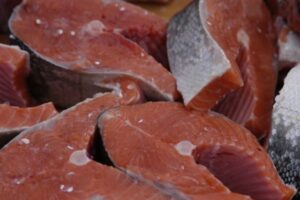Salmon Hatcheries Causing Wild Salmon Decline

With nearly half of all fish consumed in the U.S. originating on fish farms, concerns have heightened over the environmental issues associated with the practice. And a new report released by the Wild Salmon Center implicates salmon hatcheries in connection with damage to wild salmon populations.
According to a collection of 23 peer-reviewed and independent studies published in the May issue of Environmental Biology of Fishes, the expert research indicates that that five billion juvenile salmon, which have been released from hatcheries around the world, are increasing pressure on wild salmon populations causing their decline. “This isn’t just an isolated issue,” says Pete Rand, a biologist at the Wild Salmon Center in a statement, “What we’re seeing here in example after example is growing scientific evidence that hatchery fish can actually edge out wild populations.”
Among the studies’ findings is new evidence that industrial fish hatcheries cause competition for food and habitat with wild salmon. Whether or not the ocean can provide enough food is also a concern, as is the growing occurrence over cases of sea lice.
“There is no substitute for wild salmon. They must be our first priority,” said Guido Rahr, President of the Wild Salmon Center. “Wild salmon are an important part of local culture and a cornerstone of economic health for fishing communities. And once you lose the resilience that wild salmon contribute to our salmon fisheries, it’s almost impossible to bring it back. Given these new findings, we urge fishery managers across the North Pacific to examine the science and err on the side of caution when considering hatchery practices and expansions.”
Keep in touch with Jill on Twitter @jillettinger
Image: Andrea Pokrzywinski

